THE POWER OF A MORGAN PLUS 8:
FACTS AND FICTION
by Lorne M. Goldman January 1997 though modified often.
Suggestions for More Power
History
By 1965, The Morgan Company was aware that the power output
of its four cylinder engine was too small for the demands of many customers.
The Company's waiting list had shrunk to two years.
The problem was to find just the right power plant. Triumph's
solution had been to fit a great straight-six into the TR-5 but this engine
was too high to fit into a Morgan. Lotus's twin-cam was too fragile and
the Ford V-6 was too heavy.
In 1966, as a by-product of an unsuccessful take-over
feeler from Rover, Peter Morgan was offered a crack at a new Rover purchase
from Buick, a lightweight aluminium V8 called the 215 or the Jetfire
which (in 1961-62) had been standard in the Buick Skylark and Oldsmobile
F-85 (though each had different heads, intakes and exhaust arrangements).
Maurice Owen, a race engineer, was engaged to experiment
with the engine's possibilities for Morgan and worked with drawings until
he found an old Buick engine to fiddle with. The engine was literally jammed
into a Plus 4 and was rolling in early 1967. After some Leyland/Rover problems,
the Plus 8 went into production in 1968 with 20 cars delivered. As a reference
point for power, an unmodified 4/4 of that time created about 75bhp. The
first Plus 8's (1968 to 1972) put out an unmodified 160.5bhp or 170hp on
the American standard, a significant boost of power.
N.B. BHP is a measurement of the actual usable power (not
calculated power) measured at the output shaft (usually the crankshaft)
rather than at the drive shaft or the wheels. Thus none of the auxiliaries
(gearbox, generator, alternator, differential, water pump, etc.) are attached.
It is called the brake horsepower because the shaft power is usually measured
by an absorption dynamometer or "brake." This is not the brake on the vehicle's
wheels but a testing device applied to the shaft. This instrument is applied
to stop or absorb the rotation of the output shaft and returns a value.
This standard is considered a far more reliable indication of effective
horsepower than the US HP.
In January of 1974, the compression was reduced in stages
to meet the first early European emissions requirements and the power dropped
to 143 bhp. At the end of 1976, the successor engine to first the Rover
V8 was introduced called the SD1 (Specialist Division 1) and power increased
again (12bhp) and reliability increased mightily.
In 1982 Stromberg carburettors replaced the SU's as Rover
again struggled to meet European emissions standards (calling for automatic
chokes controlled by water temperature) while still maintaining the power.
The Strombergs did the trick and horsepower held at 155bhp.
In 1984, Morgan offered a few new fuel-injected version
of the high performance "Vitesse" SD1 engine as an option. The Vitesse
engine, fitted with a new gearbox, was designed by Rover to be a
competition n motor. Power jumped dramatically on the first delivered
Morgan Vitesse EFI model produced without any compromise to the car saving
a cut away of the bonnet hinge to accommodate the plenum chamber of the
engine. This Plus 8, smaller and significantly lighter than today's version,
with the tubular manifolds and twin exhaust of the day (and Morgan's new
and first rack and pinion steering a standard), left the factory unmodified
with an amazing 205bhp and an estimated 248lbft. of torque at 4000 rpm..
It was capable of 0 to 60mph in 5.15 seconds. A limited number of
these optional Vitesse EFIs were produced in the period from September
1984 to early 1985 before the weight when up, the exhaust system became
a single pipe and engines were altered.
All Plus 8's were fuel- injected after January, 1987.
The power of the Plus 8's began to drop again in 1985
(190.4 bhp) and the torque tumbled to 198 lbft. with the introduction of
more emission safeguards embodied in the addition of catalytic converters,
the return to a single from dual exhaust. Structural changes gradually
increased the weight from 1884lbs to 2068lbs. Power fell slowly but continually
to 162bhp until the production in June of 1990 of a re-bored version of
the V8 increasing capacity from 3538cc to 3946cc. The horsepower climbed
back up to near 1985 standards and the torque was even better at lower
revolutions such that Autocar (May 1991) observed that the 1991 Plus 8
(0-60 in 6.1 sec.) showed its rump to a Porsche Turbo at any speed up to
80mph.
Presently, the Morgan website still lists its 3.9 litre
engine as producing 185bhp though this figure is dated and 190.3 bhp is
a more accurate figure. (The U.S 4.0 Plus 8 produces about 186.7bhp.) The
site also shows the 4.6 litre version but does not indicate performance
specifications or details but the Morgan dealers list the 4.6's power at
194.4bhp with 260ft/lb of torque. This too is probably inaccurate and an
appeal to Land Rover directly gives more plausible figures of 218bhp and
300 ft/lb.s of torque.
N.B. I have written a supplement
to this article including a power-to-weight analysis
in response to questions on this article.
N.B. Please note this article does not apply to
Plus 8's made for the U.S. market during the
period from 1976 to 1996. Please refer to an analysis
entitled Made
in the U.S.A (1971 to 1996).
J.E. Engineering, an advance British group specializing
in the Rover V8 performance engine has recently produced a 4.5 litre based
on the same engine block that reputably produces the better part of 300
horsepower and Rpi sells a 5.2 litre model that can be camshaft adjusted
to produce greater torque or horsepower according to your needs. The dyno
claims that the engine produces 334 bhp at 5500 rpm.
N.B. As a side note here, there has been much said about
the frightening mysteries of fuel injection. It is bunk. Fuel injection
systems were clouded with rumours by the manufacturers wishing you to service
at their dealers. The Plus 8 standard ECU (Electronic Control Unit) has
an inbuilt adjustment factor of 25%.
The Rover Vitesse / Buick Jetfire are amazing lumps. With
mild attention, they easily produce the magic one-for-one solution or one
horsepower per pound weight. For this reason, they are a popular
engine swap choice among hot rodders and kitcar builders. They collect
myths and fancy like few others. I will try to distinguish some from fact
from fiction.
INSTALLING A BRANCH MANIFOLDS TWIN SYSTEM
There is no argument that an improved exhaust system is
good for the car. The engine will breathe better and engine temperatures
will drop. As the factory system installed is very restrictive, a free
flowing change is a fine adjunct to other major alterations to the engine.
A stainless or treated system is also prettier and maintenance
free.
However, exhaust is exhaust. It is not a prime ingredient
to combustion and happens after rather than before that fact. Aside from
mild adjustments to back pressure, the horsepower claims of exhaust system
sellers are simply ridiculous. You will be lucky to obtain an extra 2-3%
power from any exhaust system only but it will allow you to effect other
changes that will produce much more power than that. A twin big bore system
(2 diameter) is a start and will go well with flow-thru silencers (1976
style). The sound is simply incredible.
N.B. Remove your resonators. They are too far away
from the heat to properly clean themselves so they rust quickly, block
the airflow, reduce power and sound lousy. Please beware of the local emission
requirements if you choose to throw away your catalytic converters and
CHANGE THE RESISTOR (check out the Plus 8 page on "Cats").
Considering the price of a good full exhaust system from
manifolds to tailpipe, assume you will pay about $800.00 per horsepower
with the aesthetics unconsidered.
There is one codicil to this section that is the difference
between a single and dual exhaust system. For those of you unfortunate
to have a Morgan with a single exhaust system. Cars tested before and after
a switch from a small bore single system with manifolds to a dual large
bore system with tubular heddars have shown remarkable power increases
far beyond the minor percentages indicated above.
IMPROVING THE AIR FILTER
This is the best bargain for your horsepower dollar. The
standard paper filters, or even worse, foam filters restrict airflow
and thusly
the engine. Both dirty up over time causing further prejudice to your
power. K&Ns will clog over time as well, but that merely makes them
filter better until you clean and re-treat them with their oil again. I do mine once a year.
Off hand, I cannot think of a stock Plus 8 air filter, for carb or EFI, that does much for these engines.
K&N
produce high-capacity, low restriction washable
filters that fit without any modification. (Buy the
full K&N kit with cleaner and oil spray..you will need them) However, their Part No E-2350,
wrongly recommended by dealers for ALL EFI Plus 8s, is a disaster for the 3.9s and GEMS though adequate for the fappers (1984-1990) The cost is about $65.00 and they
can be ordered through any auto supply specialist. You can assume a 4-6% power increase for three minutes
of work on the Flapper +8s. But they create a bad blockage
for the Hotwires and GEMS. If you DO get it right, (read on) the power
imporvements can be substantial..but this fiddling is more complicated
than it looks. I highly recommend..if it is merely a
filter swap you want to do with stock 3.9s/4.0s/4.6s, that you stick
with the original paper filters..or do what I did below. Please remember, I dyno test everything.
| WATCHPOINT I FOR HOTWIRE PLUS 8s: Please note that the Hotwire engine is very sensitive
to greater airflow. The stock fuel map was made too "lean" as is and more
air can make that worse. For that reason, any improvement with a Hotwire
must begin with better fueling. (new chip hopefully an Optimax or Tornado) |
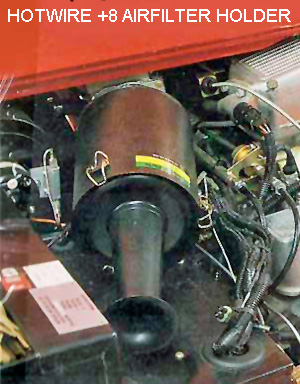 WATCHPOINT 2 FOR HOTWIRE PLUS 8s: The K&N commonly sold to fit the Hotwire trumpet air filter holder is a disaster. It works barely well enough for the earlier WATCHPOINT 2 FOR HOTWIRE PLUS 8s: The K&N commonly sold to fit the Hotwire trumpet air filter holder is a disaster. It works barely well enough for the earlier 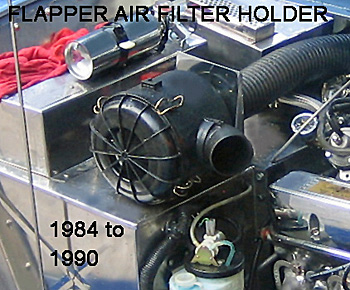 American-football
black helmet used for the Flappers (pictured on the left) but is insane for the
Hotwires (to the left). The same filter creates an air block/dam and gratly reduces bhp. I discovered this
when I swapped out MY ugly football helmet for a pretty chromed trumpet
from the Factory. The Flapper air filter holder has its inflow access from its
side and, aside from cleaning or merely turning the filter so that the
air enters a still clean part of the filter, it is a partial improvement over stock. But using the same filter in the
Hotwire trumpet is nutty, but most owners and dealers do it without a thought. Pictures tell the story. American-football
black helmet used for the Flappers (pictured on the left) but is insane for the
Hotwires (to the left). The same filter creates an air block/dam and gratly reduces bhp. I discovered this
when I swapped out MY ugly football helmet for a pretty chromed trumpet
from the Factory. The Flapper air filter holder has its inflow access from its
side and, aside from cleaning or merely turning the filter so that the
air enters a still clean part of the filter, it is a partial improvement over stock. But using the same filter in the
Hotwire trumpet is nutty, but most owners and dealers do it without a thought. Pictures tell the story.
The internal
holding plate of the trumpet blocks the airflow, forcing it to try to
find a path in the tiny space between the circumference of the filter
and the filter holder. In the main, the air comes rushing down the horn
of the trumpet and slams into the filter holding plate...and the E-2350 K&N
makes this worse. It also comes from the Factory improperly angled, as can be seen from the picture. and influences the resultant idle's steadiness aside from thinning the mixture which is sad as the stock air/fuel mixture already produces high heat. Even
on my Flapper system, I noted a significant dyno difference (I tune my Plus 8 on a dyno). On the other hand, the football helmet is super ugly! Lastly, Hotwire air/fuel mixtures cannot be easily adjusted to compensate as can Flappers (with an adjustable fuel pressure gauge and/or the flapper tension spring inside its AFM.
WATCHPOINT 3: When
I got very into experimenting with my Plus 8s, I called the UK and
struck up a friendship with their technical design team for this area. I also spoke
with other air induction experts. They all told me that a differenty
sysdtem was not always a blessing. Seems the quantity of air must
be properly complimented by shaping the air correctly or that power and
more importantly, torque, can be prejudiced unless the conduit can be
"shaped" to enhance same and its steadiness. I confirmed their advice a
number of times on a dyno. For example, attaching a large free flowing
K&N type filter directly to the MAS/AFM can increase power while
making its delivery unsteady and, in the case, of the 3.9 (which
arrives with a too lean mixture) WAY TOO LEAN. (Plus 8s have been saved
from the ravages of these over lean mixtures and other problems by the
fact that their load is so light.) Additionally, suspended cone filters
produce an unsteady flow as well.
|
CONE FILTERS:
I like them. But they do not shape the air flow as well as the right
air filter holder and conduit. And, on an enhanced Plus 8, after a
certain point of 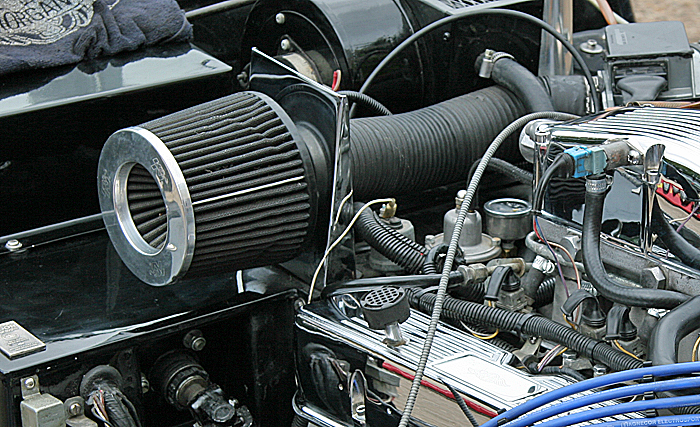 tuning
and capacity, they make (at least for me) an unacceptable induction
howl. Admittedly, this occured on my Canadian Plus 8, a lightened
Factory one-off designed by yours truly with the Works and many Morgan celebrati and powered by a tuned 4.8 LR V8 (increased
capacity from Omega pistons) and increased air flow due to Super Flares
trumpets and a larger Bosch L-Jetronic AFM from Jaguar. I found
the induction noise embarrassing..though tuning
and capacity, they make (at least for me) an unacceptable induction
howl. Admittedly, this occured on my Canadian Plus 8, a lightened
Factory one-off designed by yours truly with the Works and many Morgan celebrati and powered by a tuned 4.8 LR V8 (increased
capacity from Omega pistons) and increased air flow due to Super Flares
trumpets and a larger Bosch L-Jetronic AFM from Jaguar. I found
the induction noise embarrassing..though  the power & torque did go
up while both became unsteady. I do like engine rumble and exhaust
tone..but those, on my car, are controllable by my throttle foot. the power & torque did go
up while both became unsteady. I do like engine rumble and exhaust
tone..but those, on my car, are controllable by my throttle foot.
Interestingly, I tried the cone filter on my UK Plus
8..which is set up a bit differently. It is a lower (8.5) compression
4.6, but also with greater airflow and on a fast road cam and Jag AFM that
puts out significantly more power than stock but 42 bhp less than the
CDN car. The induction noise disappeared on this car. Image to the right. For
the holding bracket, I had one made in polished stainless steel at the local machine shop.
The image was posted to eMog in 2005 and there have been many who
copied successfully the idea since.
SOLUTION:
I
finally found a filter for CDN car that touched all the right bases and that the dynometer saluted at. :) I
have to thank the Factory Parts department in Malvern, who tempted me
with a chromed 3.9 trumpet they had!!!! Land Rover changed to the
trumpet when the discovered the back helmet restricted airflow. With the right inverted K&N cone filter, my problems with Canadian car were resolved
1. It produces as much power as the cone filter
2. It has a shaped flow and a much steadier power/torque
3. It fits into the original 3.9 Trumpet filter holder and looks like it belongs on a Morgan.
4. It allows for both indirect
AND direct airflow and eliminates the air dam, not creating the problems that a huge filter
directly on the conduit (without a filter box).
| LOW AIR INTAKES:
Avoid
forced air systems that pick up debris and force feed it to your
engine. This might make sense for racers who retrict their Morgan usage
to carefully prepared and cleaned race tracks, but make NO sense for a
road-going Morgan. I have seen or opened up a fair number of Morgan
engines and you would be appalled at their innards after a some time
with a low intake. A racer's priority is to win. However, a mogger's priority is
to have a car capable of meeting all conditions WITHOUT A RACER'S SUPPORT
INFRASTRUCTURE A COUPLE OF HUNDRED METERS AWAY and surviving these
conditions with aplomb. |
|
ADVANCING THE IGNITION TIMING (for all Plus 8s save for GEMs)
Another goodie! But you have to be careful. Dyno tests
have shown a 12-16 bhp boost is possible by advancing the engine timing up
to 4/5 degrees from the stock 6 BTC.
The care comes in for three reasons.
A) You might have trouble with this timing with consistently
hot weather ie. 95F+. So time will tell you the best advance.
B) You have to use premium gas (octane 93+ [aka 97/8 in Europe]) or better still octane
boosted premium petrol;
C) Your emissions may increase which may cause a problem
in annual testing jurisdictions.
The best way to try this is to increase the timing one
point at a time and test drive the machine up a familiar mild long slope
in a higher gear (i.e.4th) after each adjustment. When the car starts to
"ping" reduce one point and there you are!
Costs per horsepower are 0...only time and optionally
the ongoing factor of premium gas and/or octane boosters.
PERFORMANCE CHIP (for Hotwire and GEMs Plus 8s)
Your ECU can be reprogrammed with a performance chip,
a new fluel map. We have had great success with Mark Adams Tornado chips for the 3.9 and his chips for the GEMS plus 8s are a life
saver. These specialist chips deal with the mid-range power slump of the
hotwire Plus 8s and improve gas mileage. For the GEMs, they solve a slew
of issues. Power gains here are from 20-30 horsepower and costs of
the performance chip are approximately $600.00 or $20-$30 per horsepower.
OTHER POSSIBILITIES
There
are scores of other improvements to performance
that are possible with this marvellous engine. There is, however, a Law
of Diminishing Returns. Each extra horsepower costs more and
presupposes
other modifications or compromises. One should assume the maximum hp
one
can coax from and injected 3.5 or 3.9, while still being able to
smoothly
drive it to the pharmacy, is in the neighborhood of 265 hp. A carb
version can go as high 215 hp without sacrifice of a smooth idle.
There are three facts to consider. Firstly, full performance
engines run well at mid and high revolutions and poorly at low. That type
of power will not help you unless you are a racer. Secondly, most power
adjustments are concurrent applications not cumulative. In other words,
many power increasing modifications presume others will also be done so
that you can assume a power gain from each but only in concert. Lastly,
each improvement puts a strain on the whole system and a previously unnoticed
weak area can "pop" up to give you headaches.
A quick overview of other changes;
1. UPGRADE THE DISTRIBUTOR,
COIL, IGNITION AMPLIFIER AND LEADS
(all models except for GEMS)
Options here include a Mallory Unilite (NOT a Mallory
Dual Point) with Vacuum Advance. See other parts of this Manual for full
instructions. ALL Rover distributors deliver a degraded, inferior spark.
A Mallory cures that.
DISTRIBUTOR ISSUE
(for all Plus 8s except GEMs)
The Lucas Distributors/Ignition set up are all
lousy..according to any osciliscope testconfiguration of the Morgan
front end and the
placement of the distributor make for water access into the
distributor.
Inevitably, this leads to rust within the distributor, a poorer spark,
poorer combustion and trouble during damp conditions. All this leads
people
to believe that the Lucas distributor is the culprit. The solution is
quite
simple. Clean your distributor thoroughly and regularly. Be careful, as
more than one RR owner has found the rotor arm stuck fast to the
distributor
shaft when trying to replace it during routine maintenance. Pulling up
too hard on the rotor can break the plastic C-clip that holds the upper
and lower parts of the distributor drive shaft together. If it is
stuck,
try tapping DOWN with a screwdriver or chisel and break it into pieces
to get it off the shaft.
IGNITION LEADS
The stock leads are not great. Changing them to Magnecor
"Blues", Reds or "Blacks" will serve the power goal well. There is no bhp difference between the colors. I have tried them all and now use blacks.
IGNITION AMPLIFIER
(for all Plus 8s except GEMs)
On all distributors from 1976 to 1982 and from 1986 on,
the ignition amplifier module (on the outside of the distributor) can give
trouble. This item converts the magnetic impulses from the distributor
into a larger signal to fire the primary circuit in the ignition coil.
Often, the heat build-up under the hood will eventually cause this amplifier
module to fail intermittently, stalling the engine. The faulty unit can
become so sensitive to temperature that even a minute or two of cooler
air provided by opening the hood can get it working again.
2. INSTALL AN ADJUSTABLE RISING
RATE FUEL REGULATOR
(for all Plus 8s except GEMs)
This cute little item increases your fuel pressure when
you are accelerating at a faster curve than stock and is adjustable as
well..thereby effectively "reprogramming" the fueling on Flapper engines.
With Hotwire Sytsems , one still gets the acceleration boost and one can
trim the pressure to correct parameters. As well, Hotfire systems are only
closed loop until 3000 rpm. That means that after this point, the lambdas
will not null out increased fueling. Set the pressure to 40-41lbs and see
the difference.
3. INSTALL A WEBER CARBURETTOR
(for carb'ed Plus 8s only)
For carb'ed models, try the Weber/Edelbrock 4 barrelled
500 CFM. This carb will fit into a Morgan using an Offenhauser "low rider"
intake manifold. Some Plus 8s can fit the Edelbrock Performer intake. The
Weber is easy to set up and easy to maintain, rejet and rebalance unlike
the commonly used 4 barrelled Holly 390 CFM.
| (The Holly venturi size is too small for a heavy breathing
engine resulting in additional vacuum, which in turn confuses the vac secondary.
Its design also forces you to spend too much time assembling and disassembling
the thing to get it right. All to no end or a sacrifice in power in comparison
to the better designed Weber.) |
4. INSTALL PERFORMANCE INLET MANIFOLD (for carb'ed Plus 8s only)
see the Offenhauser from Edelbrock above. All intake
manifolds can also have the ports widened and polished for better airflow.
See manual for that.
5. INSTALL A PERFORMANCE
CAMSHAFT
There are many made for this engine and each have advantages
and disadvantages depending what you expect from your motor. Check out
the lines of Oselli, Kent, Piper, Crane, J.E. Motors and Crower. (The writer
prefers the Piper 270-272). Calculate 0-25 bhp depending on which of the
"reasonable" camshafts you choose.
It is wise to be very careful with the choice you make
here. It is not simply of decision of how much power you want but "where"
you want it. A cam developing large amounts of power at high rev's are
good for those of us who specialize in Autobahn racing in a straight
line with hands clutching the wheel and a crazed grin frozen on one's face
for hours. On small country roads this same camshaft will perform poorly.
6. UPGRADE THE TIMING CHAIN
Install a duplex venier timing chain. (This is an eventual
must anyway as the standard Rover chain stretches very badly over time.)
7. STROKE THE ENGINE
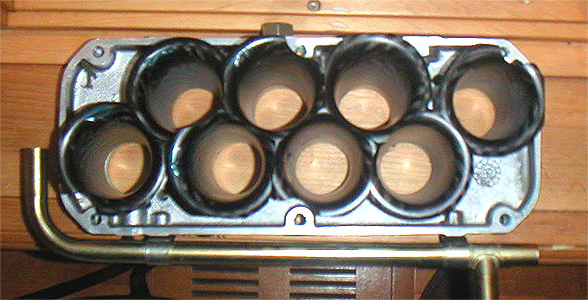 This can be done with seasoned 3.5 or the 3.9 all the
way up 5.2 litres. However, if you are going this far.. why not buy
a new lower engine block at a much cheaper price? New 4.6 blocks, with
their structural improvements and better oilways, can be had for 1500 USD
making stroking a less than ideal solution. The parts of the engines remain
interchangeable. The 4.6 can itself be modified to a capacity of 5.5L
This can be done with seasoned 3.5 or the 3.9 all the
way up 5.2 litres. However, if you are going this far.. why not buy
a new lower engine block at a much cheaper price? New 4.6 blocks, with
their structural improvements and better oilways, can be had for 1500 USD
making stroking a less than ideal solution. The parts of the engines remain
interchangeable. The 4.6 can itself be modified to a capacity of 5.5L
8. INTAKE TRUMPETS
(EFIs only)
The intake can be modified to take larger trumpets or
one can use carbon fiber Super Flares trumpets.
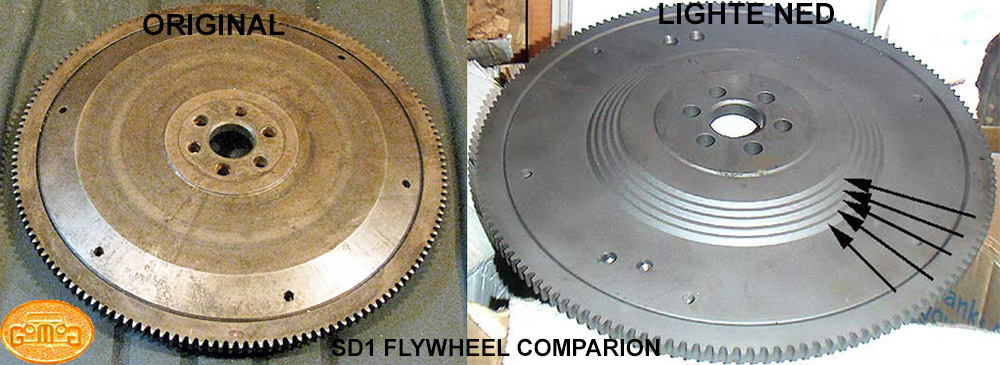
9. LIGHTENING THE FLYWHEEL
There are many other possibilities. For those of you with
a fascination for power or a yen for the "fastest" Morgan, I strongly suggest
that you adopt a "buyer beware" attitude. A good automobile is a
well harmonized compromise of many parts. Also, never believe the claims
of your "expert". No one knows the true performance of an engine without
a proper dyno testing. If you have not done this, your claims to
horsepower are most likely wishful thinking.
Come to think of it though, there is nothing wrong with
wishful thinking. Costs are nothing, installation time is negligible
and horsepower gains are unlimited.
Should you wish further information, I would suggest you email
me. There
are many other possibilities. For those of you with
a fascination for power or a yen for the "fastest" Morgan, I strongly
suggest
that you adopt a "buyer beware" attitude. A good automobile is a
well harmonized compromise of many parts. Also, never believe the
claims
of your "expert". No one knows the true performance of your engine
without
a proper dyno testing and a dyno is merely the best tuning device, not
an absolute comparison for all other engines except tested on the same
dyno.
Come
to think of it though, there is nothing wrong with wishful
thinking. Costs are nothing, installation time is negligible
and imagined horsepower gains are unlimited.
 WATCHPOINT 2 FOR HOTWIRE PLUS 8s: The K&N commonly sold to fit the Hotwire trumpet air filter holder is a disaster. It works barely well enough for the earlier
WATCHPOINT 2 FOR HOTWIRE PLUS 8s: The K&N commonly sold to fit the Hotwire trumpet air filter holder is a disaster. It works barely well enough for the earlier  American-football
black helmet used for the Flappers (pictured on the left) but is insane for the
Hotwires (to the left). The same filter creates an air block/dam and gratly reduces bhp. I discovered this
when I swapped out MY ugly football helmet for a pretty chromed trumpet
from the Factory. The Flapper air filter holder has its inflow access from its
side and, aside from cleaning or merely turning the filter so that the
air enters a still clean part of the filter, it is a partial improvement over stock. But using the same filter in the
Hotwire trumpet is nutty, but most owners and dealers do it without a thought. Pictures tell the story.
American-football
black helmet used for the Flappers (pictured on the left) but is insane for the
Hotwires (to the left). The same filter creates an air block/dam and gratly reduces bhp. I discovered this
when I swapped out MY ugly football helmet for a pretty chromed trumpet
from the Factory. The Flapper air filter holder has its inflow access from its
side and, aside from cleaning or merely turning the filter so that the
air enters a still clean part of the filter, it is a partial improvement over stock. But using the same filter in the
Hotwire trumpet is nutty, but most owners and dealers do it without a thought. Pictures tell the story.  tuning
and capacity, they make (at least for me) an unacceptable induction
howl. Admittedly, this occured on my Canadian Plus 8, a lightened
Factory one-off designed by yours truly with the Works and many Morgan celebrati and powered by a tuned 4.8 LR V8 (increased
capacity from Omega pistons) and increased air flow due to Super Flares
trumpets and a larger Bosch L-Jetronic AFM from Jaguar. I found
the induction noise embarrassing..though
tuning
and capacity, they make (at least for me) an unacceptable induction
howl. Admittedly, this occured on my Canadian Plus 8, a lightened
Factory one-off designed by yours truly with the Works and many Morgan celebrati and powered by a tuned 4.8 LR V8 (increased
capacity from Omega pistons) and increased air flow due to Super Flares
trumpets and a larger Bosch L-Jetronic AFM from Jaguar. I found
the induction noise embarrassing..though  the power & torque did go
up while both became unsteady. I do like engine rumble and exhaust
tone..but those, on my car, are controllable by my throttle foot.
the power & torque did go
up while both became unsteady. I do like engine rumble and exhaust
tone..but those, on my car, are controllable by my throttle foot. 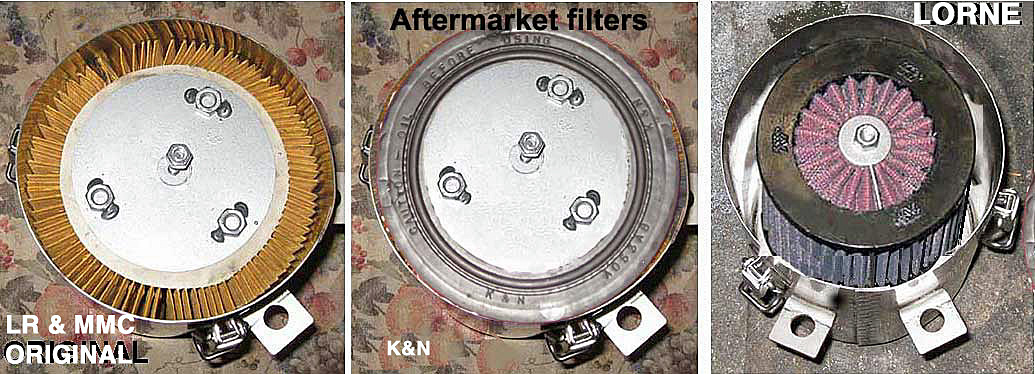
 This can be done with seasoned 3.5 or the 3.9 all the
way up 5.2 litres. However, if you are going this far.. why not buy
a new lower engine block at a much cheaper price? New 4.6 blocks, with
their structural improvements and better oilways, can be had for 1500 USD
making stroking a less than ideal solution. The parts of the engines remain
interchangeable. The 4.6 can itself be modified to a capacity of 5.5L
This can be done with seasoned 3.5 or the 3.9 all the
way up 5.2 litres. However, if you are going this far.. why not buy
a new lower engine block at a much cheaper price? New 4.6 blocks, with
their structural improvements and better oilways, can be had for 1500 USD
making stroking a less than ideal solution. The parts of the engines remain
interchangeable. The 4.6 can itself be modified to a capacity of 5.5L
